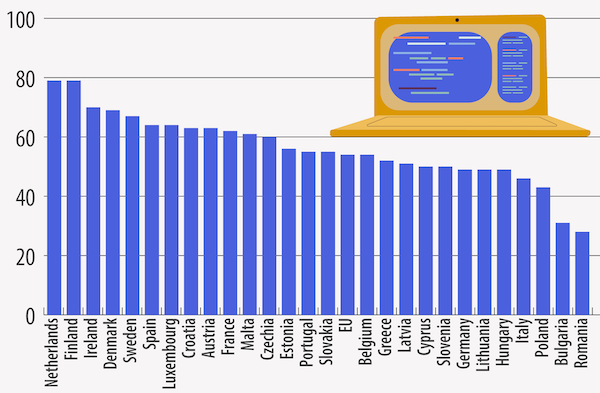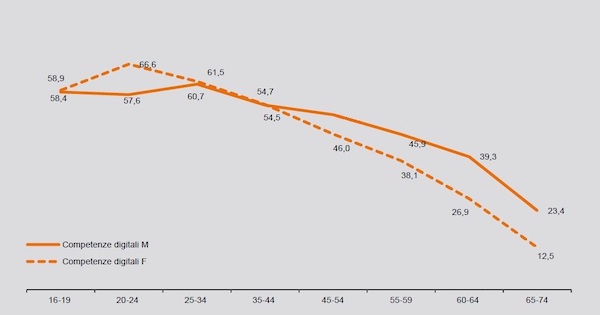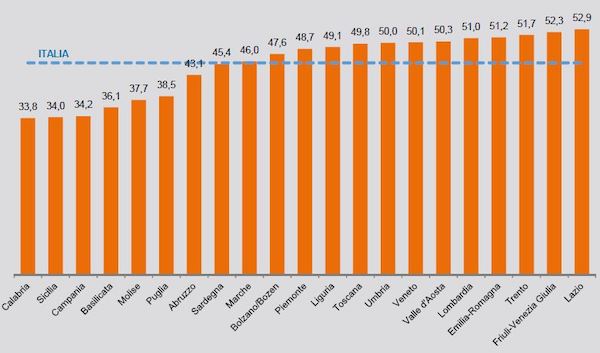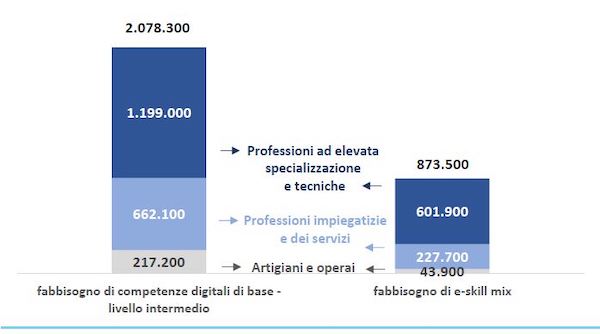| Lottomatica Foundation and Percorsi di secondo welfare started a collaboration on the topic of sustainability. Our Laboratory will accompany the Foundation in defining a programme agenda that takes sustainability issues into consideration. Alongside more strictly research activities, we will also propose some thematic in-depth studies that will be published on the Foundation’s website. This article is part of a series of articles we will write on the various facets of social and environmental sustainability. It has been published on the Lottomatica Foundation website and is also available in Italian. |
Digital skills are essential for business development and, consequently, for the Italian economy as a whole. This is why Europe has been calling on member countries to invest in this area for years. In 2021, the European Commission approved a strategy that identified some digital objectives to be achieved by 2030, inaugurating the “European Digital Decade.”
How difficult will it be to achieve these goals? Do Italians have good and widely available digital skills? And what do companies think about this?
What the data says: Countries and regions compared
Alongside the promotion of strategies and initiatives for digitalisation, Europe is carrying out an essential task of data collection. With regard to digital skills, according to the 2021 survey, Italy ranked fourth in Europe. Just under half of the population has basic skills, a result that is still far short of the European goal of 70% by 2025 (see graph 1).

This survey covers the population between 16 and 74 years of age. Overall digital skills are in five areas: computer science and data literacy, communication and collaboration, digital content creation, security knowledge, and problem solving.
In Italy, ISTAT has also adopted these categories since 2021, redefining its statistical indicators in this area. According to the BES 2022 Report, published by Istat in 2023, 45.7% of people aged 16-74 in Italy have at least basic digital skills, compared with the EU-27 average of 53.9%. The average figure, however, shows great variability (see graph 2).

Looking at the distribution of digital skills in our society, a first relevant variable is age: the older people are, the fewer skills they have. In any case, compared to the European average, Italy has lower results in all population groups: 61.7% of young people aged 20-24 living in Italy have basic digital skills, compared to 72.7% of their European peers. The Italian figure for people 65-75 years of age is 17.7%, or seven percentage points less than the average European value for the same age group.
Gender also emerges as a significant variable, although only from the 45-54 age group. If older women are less digitally competent, the same cannot be said for young women between 20 and 24 years of age, who are more competent than their male peers.
A third variable concerns educational qualification. According to the BES 2022 Report, people with higher education are more likely to possess digital skills: they are found in 75.9% of respondents with at least one degree, compared to 53.8% of those with a secondary diploma and 21.9% of people with a lower qualification.
Finally, the geographic variable should be emphasized, as shown in graph 3: digital skills are less widely found throughout the regions of Southern Italy.

The perspective of companies
Digital skills are an essential factor for company growth. As the latest Unioncamere report on digital skills (Unioncamere 2022a) tells us, “Macroeconomic estimates by the consulting firm McKinsey & Co. place the growth potential for the European Union’s digital transformation in the order of a cumulative increase in GDP of more than 14% by 2030″. To reach this potential, however, reforms and investments, both public and private, are needed “for training, education, skill upgrading and retraining of the workforce to manage the digital transition.”
In addition to a series of investments by companies, for example, in the field of invoicing and digital marketing (Unioncamere 2022a), it is therefore essential to qualify the workforce so that it can implement the transformations underway and those to come. . The workforce in Italy starts from a disadvantaged position in this respect: 75.6% of the 15-74 age group (25,127,000) are people of 35 years of age or older, with almost half of them between 50 and 74. As graph 2 highlights, lower levels of digital skills begin to be seen starting from the group 35-44 years of age.
The picture is also confirmed by investigations that directly involve companies, such as the surveys by the Excelsior Information System (created by Unioncamere and ANPAL – the Italian National Agency for Active Labour Market Policies)1. The report entitled “Forecasts of employment and professional needs in Italy in the medium term (2023-2027)” (Unioncamere 2022b) identifies two groups of skills essential for business development, also in light of the objectives set by the PNRR: “green” and digital skills. Unioncamere underlines that digital skills are now considered a basic skill for most workers and estimates that over the next five years they will be required by just over 2 million employees (over 56% of total needs). High digital skills will be required by over 870,000 professionals (about 24% of total needs). As graph 4 shows, however, these skills will be required in all sectors and at all levels of specialisation.

Although digital skills are essential, they are also difficult to find. This fact does not seem surprising, given the demographic profile of the workforce in Italy. The latest Unioncamere annual report on digital skills (Unioncamere 2022a) shows “a further worsening of the mismatch between digital skills and labour demand”: in 2022, companies noted difficulty in recruiting professionals with the required digital skills amounting to 41.8% of total planned recruitment. This figure rises in the case of companies that have made significant steps towards digitalisation: companies that made digital investments in 2022 declared a rate of recruitment difficulty amounting to 60.2% of planned intake.
The work digitalisation challenge seems enormous and of fundamental importance: a substantial part of the potential development of Italian and European companies depends on it. Therefore, it is essential to put in place a complex set of actions that can retrain the current workforce and provide greater basic and high skills to the workers of the future. The challenge of digitalisation can only be overcome if we start from school.
References
- Istat (2023), BES Report 2022.
- Unioncamere (2022a), Digital skills. Analysis of demand for digital skills in enterprises, survey 2022.
- Unioncamere (2022b), Forecasts of employment and occupational needs in Italy in the medium term (2023-2027). Scenarios for orientation and training planning.
Note
- The collection of data provided by the Chambers of Commerce and monthly surveys on companies offer an updated picture of the labour demand of companies and the main characteristics of the required professionals (education, age, experience, difficulty in recruitment, digital skills, etc.). On the basis of these data, Unioncamere prepares some annual reports, including the aforementioned detailed study on digital skills (Unioncamere 2022a).